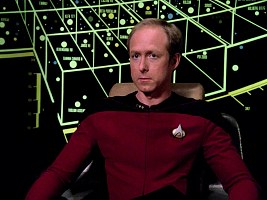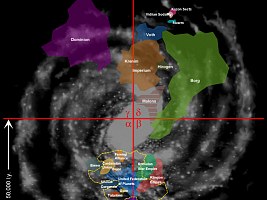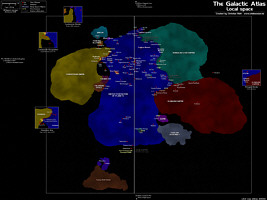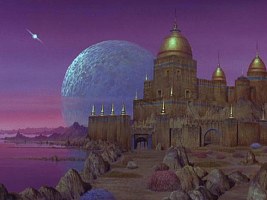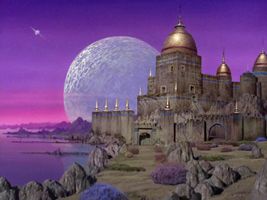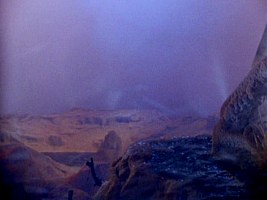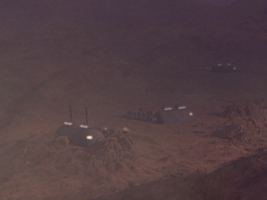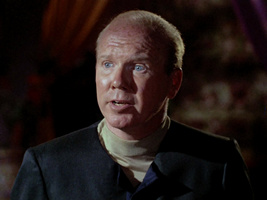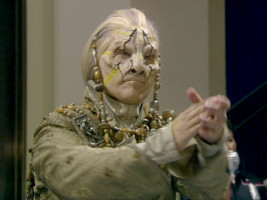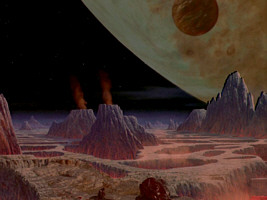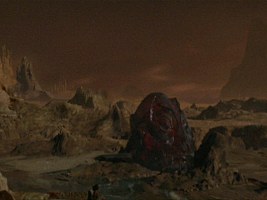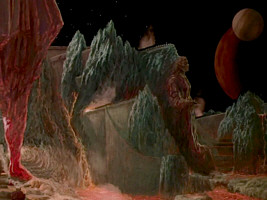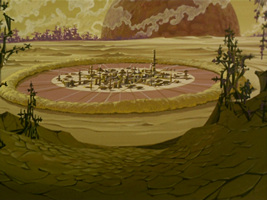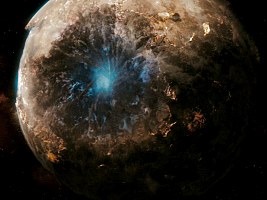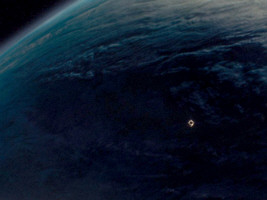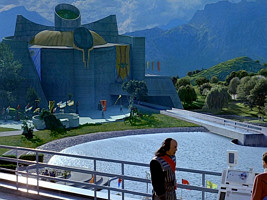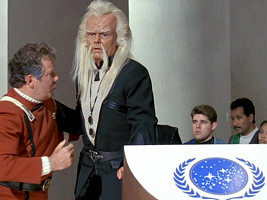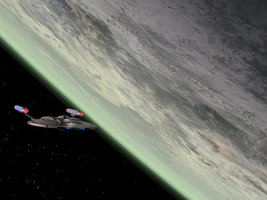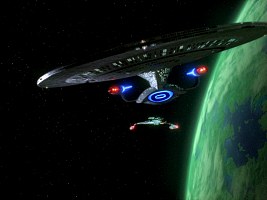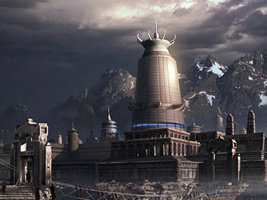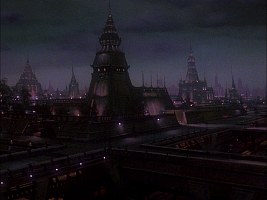Other Cartography Inconsistencies
The FederationThe Rigel SystemVulcan's MoonMiscellaneous
The Federation
Warp factors and actual speeds
The very concept of Star Trek requires a starship that is fast enough to provide sufficient adventures during a five-year mission and that would be able to travel to a new planet every week - as opposed to the boring routine on a sleeper ship or generational ship that would always be somewhere between the stars. The requirement to cross the distance between neighboring star systems, in the range of a couple of light-years, in only few days led to the "invention" of the warp drive, Star Trek's faster-than-light warp propulsion. Still, the warp drive didn't have to be too fast, since for dramaturgic reasons it was usually not desired that the Enterprise could arrive "at once" after receiving a distress call. Moreover, if the whole galaxy could be traversed within a few years, there would not be much left to be explored in future missions. These are the reasons why the TOS starships as well as the TNG starships are significantly faster than light, but slow enough to be restricted to the space of parts of the Alpha Quadrant and Beta Quadrant. With TOS-Warp 6 (216c) a star system 5ly away could be reached in eight days, which was shortened to one day with TNG-Warp 9 (1516c) - speeds as listed the Star Trek Encyclopedia.
O the other hand, we have to keep in mind that ultimately the concept of warp speeds and interplanetary distances and essentially the whole galactic cartography of Star Trek is plot-driven.
The size of the Federation
Only scarce facts are known about the extent of Federation space:
- The most striking evidence is a map in Starfleet Headquarters in TNG: "Conspiracy", which reappears in Keiko's class room on DS9, now showing many place names of Star Trek fame. Nearly a quarter of the galaxy of 100,000ly diameter is either known or is even part of the Federation.
- A map in TNG: "The Chase" suggests that Prof. Galen crossed almost a third of the Galaxy.
- Picard tells Lily in "Star Trek: First Contact" that it is 8,000ly across. According to the Star Trek Encyclopedia and other officially approved sources, the diameter of Federation space is about 10,000 light years.
The two latter figures are roughly the same, but they have to be called into question, because they are still much too great in light of the established speeds. At Warp 9, it would take almost seven years to cross this distance as can be seen in the modified warp table in the TNG Technical Manual, which is reproduced above. This duration appears to be much too long to hold together a complex political system like the Federation. The same applies to the Romulan Empire and the Klingon Empire that are supposed to be the same order of size and that couldn't possibly be ruled by a central government if it took years to travel from one edge to the other. Moreover, only the most sophisticated starships are capable of achieving Warp 9, not even taking into account that they may need to stop for maintenance or refueling after a few months of uninterrupted warp flight. Nevertheless, the Enterprise-D or her crew are running across Federation space in all directions. They reach Earth ("Conspiracy", "Best of Both Worlds", "The First Duty", "Time's Arrow") as well as Deep Space 9 ("Birthright"), the Klingon Homeworld ("Sins of the Father", "Redemption") and the Romulan Homeworld ("Unification"), all of which are supposedly located on opposite edges of Federation space. If the extent of Federation space and the warp speed table are both correct, these journeys would have taken more than a lifetime, still not taking into account that countless other destinations (with unknown absolute coordinates) may have been far beyond the Federation borders, for we know that the Enterprise-D is mainly a ship of exploration.
The people in charge obviously noticed that when DS9 was being produced. According to the DS9 Technical Manual, the core worlds of the Federation are no more than 50ly from DS9. This was the only way to allow the crew of DS9 to visit Earth on their vacation, and to show storylines such as the Dominion War that involves the Federation as a whole and not only some outposts in the same sector. Most of the mentioned speeds and distances make sense again, if we reduce the diameter of the Federation to about 200ly. It is interesting in this regard that most of the real star systems mentioned in Star Trek, such as Altair, Aldebaran, Alpha Eridani or Gamma Trianguli are within this 200ly range. On the other hand, there are a few notable exceptions, like Rigel or Antares that are both many hundred light years away. Maybe these are isolated colonies?
Something to be taken into account too is that there are supposed to be only 150 to 200 member planets, while we can take for granted that even in a diameter of 200ly there are most likely a few thousand inhabitable planets. In Enterprise, the radius of exploration is only 100ly as of season 2. Still, the ship encounters dozens of different species within about one light year (sensor range) along its course. We may assume roughly one thousand inhabited worlds within the 200ly diameter. It would be only plausible if even in the 24th century many of these planets are still independent enclaves, although they are surrounded by what is customarily referred to as "Federation territory". Still, the number of only 150 members seems to be quite low. At least, we can presuppose that this figure only comprises "full members". Mars, for instance, is colonized in the 24th century (until 2385), but may be regarded as a part of Earth (or of the Sol system).
For much more on this topic, go to the incredibly detailed cartography section at Star Trek Dimension.
The population of the Federation
The only figure telling us anything about the population of the Federation is the expected 900 billion death toll of the Dominion War (DS9: "Statistical Probabilities"). This figure seems exaggerated. It would give us a total population of the Federation of well above 1 trillion. Is this realistic?
Earth currently has a population of 8 billion. Although this figure will keep rising, it is not economic, much less desirable if it were much higher in the 24th century. Vulcan has a population of 6 billion in 2258, according to "Star Trek (2009)". So an average of 7 billion inhabitants per member planet may be a starting point, assuming that Earth and Vulcan are average planets. With 150 member planets, this would give us 1.05 trillion. Most colonies can be supposed to have a much smaller population, but we don't know their number. Anyway, according to this rough suggestion, a total Federation population above 1 trillion seems possible. Still, with "only" several billion humans (Earth plus colonies) among a trillion, it remains a problem why humans are that dominant in the Federation. Maybe it is just because humans like to travel and to explore that they are seen everywhere.
The Rigel System
Rigel is a real star almost 800 light years away from Earth. It would take years to travel from Earth to the Rigel system even at high warp, so already the original Enterprise's journey to Rigel VII in "The Cage" was problematic to justify. In the following, however, Rigel was frequently referenced in Star Trek, and not as a remote destination of exploration but rather as a core world of the Federation with a diverse culture and a high population density.
The following particular planets in the Rigel system were shown or mentioned in some fashion:
- Rigel II: On this planet Dr. McCoy once met two cabaret girls, who are recreated from his memory on the Shore Leave Planet (TOS: "Shore Leave").
- Rigel III: In an alternate future, Geordi lives on this planet with his wife Leah (TNG: "All Good Things").
- Rigel IV: Mr. Hengist, who later went to Argelius, is a native of this planet. The Argus River region on the planet is known for its wood carvings (TOS: "Wolf in the Fold"). Rigel IV is also referenced a couple of times in TNG and DS9. It hosts a conference (DS9: "The Wire") and it is the site of a pergium refinery (DS9: "Prodigal Daughter").
- Rigel V: This planet is inhabited by a species known as Rigelians (TOS: "Journey to Babel").
- Rigel VII: The planet is the home of a medieval humanoid civilization, the Kaylar. Captain Pike loses three members of landing party when the Kaylar attack ("The Cage"). There is a song called "Moon over Rigel VII" ("Star Trek: The Final Frontier") in the 23rd century, and at latest by the 24th century the planet (or part thereof) is "civilized" (DS9: "The Passenger").
 Captain Pike revisits Rigel VII five years later. A crew member named Zac, who was believed to be dead, has influenced the culture of the indigenous population (new spelling: Kalar). It turns out that an asteroid in orbit caused amnesia among the Kalar, but the Enterprise tows it away and enables a normal development of the planet (SNW: "Among the Lotus Eaters").
Captain Pike revisits Rigel VII five years later. A crew member named Zac, who was believed to be dead, has influenced the culture of the indigenous population (new spelling: Kalar). It turns out that an asteroid in orbit caused amnesia among the Kalar, but the Enterprise tows it away and enables a normal development of the planet (SNW: "Among the Lotus Eaters").- Rigel X: Enterprise NX-01 visits this planet in 2151. Humans have never heard of the Rigel system before (ENT: "Broken Bow").
- Rigel XII: This planet with its harsh environmental conditions is the site of a dilithium mining facility in the 23rd century (TOS: "Mudd's Women").
Besides the obviously native inhabitants of Rigel VII, many denizens of the Rigel system appear to be human. We can see the native population commonly referred to as Rigelians as late as in Enterprise's fourth season (ENT: "Affliction", "Demons", "Terra Prime").
The first question is how a planet so far away from Earth can be a destination of Enterprise NX-01 as soon as in 2151, while the ship's farthest distance from Earth is firmly established as being just 150 light years in ENT: "Horizon". As a matter of fact, in "Broken Bow" Rigel is said to be "15ly from our present position". By any means this Rigel can't be the same as the real star of the same name. In addition to the problem of the distance that ENT inherited from TOS, it is very ignorant writing that neither Archer nor Hoshi are familiar with the Arabian name Rigel but that it comes from a Klingon flight plan in "Broken Bow"! There is another actual star with a similar name, Rigil Kentaurus, more commonly known as Alpha Centauri. But Alpha Centauri, only 4 light years from the Sol system, is already a human colony by the time of "Broken Bow" and must be ruled out as well.
Rigel X as in ENT: "Broken Bow" should be in the same star system as the various Rigel planets in TOS and the other series in order to avoid even further confusion. It would make a lot of sense if the TOS Rigel were much closer to Earth than the real star. The Rigelians may have been technologically superior to humans in 2151, at least they already maintained a busy interstellar trade outpost on Rigel X. While their home may be on Rigel V, they may have admitted human settlers and miners to some of the less developed planets of their system, in particular Rigel II and Rigel XII. Hence the perhaps wrong impression of a human domination of Rigel in the 23rd century.
While Rigel VII may have either made great progress or may have been partially turned into a reservation for the indigenous Kaylar, it only remains a problem to explain the "primitive" wood carvings on Rigel IV, unless this planet were the home to yet another otherwise unmentioned third indigenous species of the system. On the other hand, it wouldn't be unheard of if settlers from some other world had imported their traditional way of living. Alternatively, Rigel IV could be the homeworld of the species known as the Rigelians, rather than Rigel V. It would make sense considering that Rigel IV is the more prominent planet, it would only be implausible to refer to the human Mr. Hengist as a native of an alien planet. But perhaps he is a diplomat's son?
Anyway, while every planet of the system may have a different status, the people as they could be clearly seen in ENT: "Demons" for the first time are still the species commonly referred to as Rigelians and the ones who run starships with Rigelian registry.
Vulcan's Moon
"Vulcan has no moon." This is what Spock tells Uhura in TOS: "The Man Trap". Yet, in the original version of "Star Trek: The Motion Picture" (TMP) there are two celestial bodies visible in the kolinahr scene, one enormous that covers much of the sky and one moon-sized. Vulcans don't lie, and why should Spock lie to Uhura without reason?
As if someone had noticed this goof, a completely new scene without the planets and/or moons was created for the TMP Director's Cut DVD. However, Michael Matessino, who worked on the restoration of TMP, explains the actual reason for the revision: "We eliminated things that you might not associate with a far-off monastic temple. We did not take our directions from a simple line of dialog. Vulcan in and of itself should be interesting without cluttering the sky. Besides, it was obvious that the sun was out in that scene. The change keeps things in the spirit of where we are going. It's not about what's up in the sky, it's about what's happening with Spock." (Star Trek: Communicator, Issue 136).
Anyway, the scenes from the two versions of TMP would contradict each other. They might be views in different directions, but aside from the different landscape the sky is dark in the original version, whereas it is a diffuse reddish brown in the Director's Cut. The latter is also closer to what Vulcan looked like in TOS: "Amok Time". The question is which of the two versions we should take as the true one. And regarding the existence of a Vulcan moon, we still have Tuvok's statement in VOY: "Unimatrix Zero" that he was born on "Vulcanis Lunar Colony". "Vulcanis" was a preliminary name used for Vulcan very early in TOS, and it is strange that it is suddenly resurrected here (especially since a Vulcan wouldn't use an alternative human name for his home planet).
A popular explanation for the TMP theater version was that Vulcan and a twin planet could be spinning around each other. The larger body would be the twin planet, the smaller one the twin planet's moon, the one Tuvok was born on. The Director's Cut, on the other hand, would strictly comply with Spock's statement.
Rama Ramalingam suggests that the landscape in the TMP theater version does not have to be Vulcan: "The Kolinahr ceremony may have been conducted on a Vulcan colony planet. From ENT's 'The Andorian Incident', we know that such worlds have existed for a long time. TMP never explicitly indicated that the planet was Vulcan. Another explanation is that Spock was on a Vulcan version of a holodeck. We never see him leave the scene, after all. It wouldn't be implausible that Vulcans use different landscapes & settings in practicing their mental disciplines." On the other hand, Spock later explicitly states that he sensed the consciousness (of V'ger) on Vulcan.
George Wade's take on the issue: "Actually it's pretty simple, looking at the scene on Vulcan from the theatrical release of ST:TMP we see a huge 'object' hanging in the sky, and a smaller object. The big object looks to have an atmosphere. My theory is that Vulcan has a twin planet, call it B, and they orbit each other around a common gravitational point. Vulcan and B are almost nearly of equal size but B is slightly larger so if one must be totally truthful Vulcan is more under the gravitational influence of B than visa versa. Therefore Vulcan is more a moon of B than B a moon of Vulcan, so Vulcan has no moon. But that scene in ST:TMP is perfectly explainable, it is simply B rising in Vulcan's sky. As for the third object, let's call it C, that is simply B's moon, and as for Tuvok being raised on a Vulcan Lunar colony, that colony could logically be located on C. You can also use the Romulans as a back up to this theory, Romulus and Remus are a twin planet system, if we assume, and I do as I don't think its ever been officially said otherwise, that they orbit around a central gravitational point. When the Proto-Romulans left Vulcan they settled on several class M planets but never stayed, they always pulled up stakes and left until they reached Romulus where they stayed? Why? I propose that they either originally set out for the twin planets or Romulus and Remus or settled there because they reminded them of the twin planets of Vulcan and B, there seems no other reason to go so far than to find a 'new home'."
Edward Shipp on the "Vulcanis Lunar Colony": "'Lunar' in Star Trek tends to refer specifically to the place where Neil Armstrong truly went where no man has gone before, as opposed to a general term for moon. Tuvok's father was probably in Starfleet, so it would make some sense if his family lived on or near Earth. Given Vulcans' general isolationist tendencies, I have no trouble believing that they'd have their own separate settlement somewhere like the Moon."
Michael Minnick found an additional blooper in the original theater release of TMP. The matte painting that is shown just after the cut to Spock doesn't match the previous one: "The two planets (which shouldn't be there) swap colors and reduce in size... The camera angle is also different which might actually insinuate a second set of planets, but that should just be ignored." This blooper may be the final nail in the coffin of the theory that the original release may depict the "true" Vulcan scenery.
 A large moon-like body was already present in Vulcan's sky in TAS: "Yesteryear", the one episode that was purportedly always meant to be canon. It may have even served as an inspiration for the TMP version of Vulcan.
A large moon-like body was already present in Vulcan's sky in TAS: "Yesteryear", the one episode that was purportedly always meant to be canon. It may have even served as an inspiration for the TMP version of Vulcan.
 The planet called "Delta Vega" in "Star Trek (2009)" is definitely located in the same star system as Vulcan and has the name in common with the remote colony from "Where No Man Has Gone Before" for the hell of it. Roberto Orci stated: "We moved the planet to suit our purposes. The familiarity of the name seemed more important as an Easter egg, than a new name with no importance." Anyway, old Spock can apparently see the dying planet Vulcan in the day sky of Delta Vega, much like the huge Vulcan moon or sister planet is visible from the surface of Vulcan. So "Delta Vega" is indeed a candidate for what was visible in TMP and TAS. This planet would have to be bigger than Vulcan itself.
The planet called "Delta Vega" in "Star Trek (2009)" is definitely located in the same star system as Vulcan and has the name in common with the remote colony from "Where No Man Has Gone Before" for the hell of it. Roberto Orci stated: "We moved the planet to suit our purposes. The familiarity of the name seemed more important as an Easter egg, than a new name with no importance." Anyway, old Spock can apparently see the dying planet Vulcan in the day sky of Delta Vega, much like the huge Vulcan moon or sister planet is visible from the surface of Vulcan. So "Delta Vega" is indeed a candidate for what was visible in TMP and TAS. This planet would have to be bigger than Vulcan itself.
Miscellaneous
Khitomer's affiliation
The Federation looks like the host of the Khitomer Conference in "Star Trek VI" because the Federation President welcomes the delegates of the other civilizations and the speaker's desk is decorated with the Federation emblem. Also, Sulu speaks of "Camp Khitomer, near the Romulan border". Considering that no one seems to know the place and Sulu bothers to add "near the Romulan border", would he add such a hint if it were in Klingon territory? This is why Khitomer very likely does not belong to the Klingon Empire as of 2293. Four decades later, however, the planet hosts a Klingon outpost at the Romulan border, as mentioned in TNG: "Sins of the Father". Would the Federation as the obvious winner of the cold war give away the planet?
This dialogue from "Star Trek VI" sheds a different light on the question:
President: "We hope you will be our guests here on Earth."
Azetbur: "After recent events you will understand if I say I prefer a neutral site. And in the interest of security let us keep the location secret for now."
So the Federation and the Klingons have been looking for a neutral location. The Klingons seem to have chosen the location, and perhaps they left the honor of preparing it to the Federation. If Khitomer was neutral at that time, the Klingons may have conquered it later.
The evacuation of Qo'noS
At the Khitomer Conference, the Federation President holds a speech that includes the following section:
President: "The proposed agenda is as follows. The total evacuation of Kronos [which is how Qo'noS is spelled in the closed captions] has been calculated within the fifty Earth year time span. Phase one, preparation for evacuation..."
So did all Klingons eventually move to another planet, which they retroactively named Qo'noS and which can be seen in TNG and DS9?
Actually, the Klingon homeworld is not shown at all in "Star Trek VI". But it is the first time in Star Trek that Qo'noS (or Kronos) is called by its name. The planet previously appeared but was referred to as "First City" in TNG: "Sins of the Father" and as "Klingon homeworld" in TNG: "Redemption I". The first episode set in the 24th century to mention Qo'noS and link it to the visuals established in TNG is DS9: "The House of Quark". Finally, in ENT: "Broken Bow", Enterprise NX-01 visits the planet as soon as in the 22nd century. The planet looks much paler than in TNG and DS9, which we may or may not accept as a combination of different lighting conditions and artistic license.
Most of our visual and verbal evidence of Qo'noS would allow the interpretation that the Klingons moved to a different planet after the Praxis disaster and gave it the same name. In the Klingon language, Qo'noS is a proper noun as opposed to juHqo' ("homeworld"). So the simple explanation that they refer to the new planet as "homeworld" is not an option, though.
Still, there are some problems with the idea that Qo'noS was moved. Parts of the First City, which are explicitly referred to as "Old Quarter" in "Sins of the Father", look like they have been around for centuries. We may blame neglect as the reason, but it makes more sense if this quarter really is old. As for the reasons why it is considered to evacuate Qo'noS in the first place, Spock mentions that "the moon's decimation means a deadly pollution of their ozone. They will have depleted their supply of oxygen in approximately fifty Earth years." If ozone depletion is the whole problem, it seems like it could be solved with 23rd century technology. There is no mention of the evacuation except in the speech of the President, who calls it a "proposed agenda". Also, it may be much less of a logistical effort to regenerate Qo'noS than to move billions of people to another planet and erect new infrastructure there. Overall, it is more likely that the Klingons stayed on Qo'noS.
 In "Star Trek Into Darkness", we can see a half destroyed celestial body near the edge of the Klingon territory. This is quite obviously a homage to "Star Trek VI", but the moon would have exploded much sooner in the Kelvin Timeline and does not orbit Qo'noS as the plot of the classic movie requires it. So we may just pretend it is a different moon that has broken up for some reason. And for what it's worth, Qo'noS looks more Earth-like in the Abramsverse.
In "Star Trek Into Darkness", we can see a half destroyed celestial body near the edge of the Klingon territory. This is quite obviously a homage to "Star Trek VI", but the moon would have exploded much sooner in the Kelvin Timeline and does not orbit Qo'noS as the plot of the classic movie requires it. So we may just pretend it is a different moon that has broken up for some reason. And for what it's worth, Qo'noS looks more Earth-like in the Abramsverse.
Leningrad! Really?
It is only a small nit, but during the Whale Probe crisis in "Star Trek IV" someone in the operations center at Starfleet Headquarters reads the atmospheric conditions at several places, including "Leningrad". For all we know the city of Leningrad doesn't exist any longer since 1991 when its former name of Saint Petersburg (actually written Санкт-Петербург = "Sankt Peterburg" in Russian) was restored. It is obvious that when the movie was being made in 1986 nobody could have predicted the downfall of communism. Still, it needs to be addressed why there is a "Leningrad" in the 23rd century, named for a cruel communist dictator.
There are two further mentions of Leningrad in Star Trek. The first is when Pavel Chekov, in the course of his legendary "Russian inwention" running joke in TOS: "The Trouble with Tribbles", claims that Scotch whisky was actually invented by "a little old lady from Leningrad". But we may discount this as a historical reference. The other one is when he calls the planet in TOS: "I, Mudd" "better than Leningrad". This is a bit problematic, as it insinuates that he has actually been to Leningrad.
There are various possibilities to explain the name "Leningrad" in the 23rd century, the least desirable of which would be that by that time totalitarian icons would be revered again (which has actually been cited by Star Trek detractors as "evidence" for being communist). It is possible that "Leningrad" refers to a smaller, maybe new-founded city or to the region (oblast) around Saint Petersburg which, in spite of everything, is still named Leningrad as of 2021. But perhaps the guy who mentions Leningrad in "Star Trek IV" is just kidding, maybe he even comes from Saint Petersburg and expects everyone to know what he's talking of (although the situation for a joke seems inappropriate).
See Also
Warp Propulsion - 6 Warp Speed Measurement
Races with Changing Faces - Other Races - Gorn, Tholians, Nausicaans, Talarians, Tarkaleans, Rigelians, Coridans, Yridians, etc.
Planet Mutations - recurring planets whose appearance varies
Credits
Many thanks to Christian for his great maps and for many facts about the size of Federation space, to J. Wilder for reminding me of Rigil Kentaurus and to Thomas for the quote about Khitomer. Thanks to Luther Root and Michael Minnick for additional suggestions and scrteen caps about Vulcan's moon.

Star Trek Cartography @ Star Trek Dimension






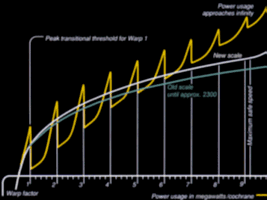
 Official warp speed diagram
Official warp speed diagram